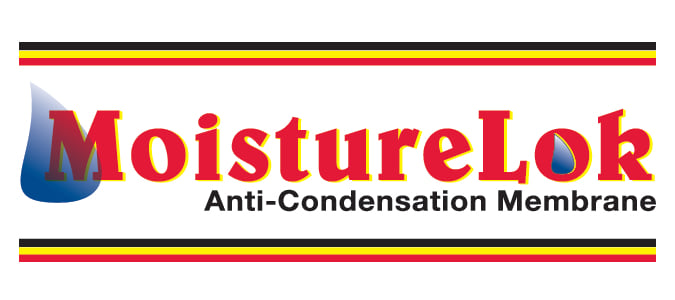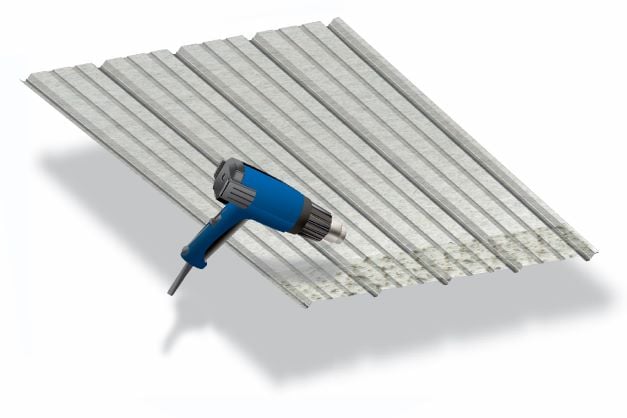- Home
- Products
- Accessories
- Moisture-Lok
Metal Roofing Accessories
MoistureLok

Factory Applied Anti-Condensation Membrane
When the temperature and humidity conditions reach the dew point, moisture condenses on the underside of metal roofing and forms droplets of water, which can cause damage to the contents of a building.
Roof panels with McElroy's MoistureLok, provide a medium for trapping this moisture in the specially designed pockets formed in the membrane.
The material holds that moisture until conditions go back below the dew point. The moisture is then released back into the air in the form of normal humidity.
MoistureLok is the McElroy Metal trade name for the DripStop product line.
The MoistureLok Advantage
Materials
MoistureLok eliminates the need to inventory and install conventional vapor barrier materials
Cost
MoistureLok eliminates costly field labor installing on-site vapor barriers
Aesthetic
MoistureLok eliminates unsightly rips and tears often associated with conventional vapor barriers
Maintenance
MoistureLok is bacteria resistant and easily cleaned with a hose or pressure washer

Installation Details
To prevent capillary or wicking action, the MoistureLok membrane should be field-treated (glazed) with heat to fuse the fibers. Glazing is a process of melting MoistureLok fibers to help prevent the wicking process. Please refer to McElroy Metal’s MoistureLok and Capillary Action flyer for more details about MoistureLok and Glazing.
Panels with MoistureLok can be lapped. To prevent wicking into the lap, we recommend the bottom two to three inches of overlapping panels and trim also be glazed.
MoistureLok is available on these panels
*MoistureLok is not available at all McElroy Metal facilities. Extra lead times may apply.
MoistureLok is available on these panels
*MoistureLok is not available at all McElroy Metal facilities. Extra lead times may apply.
MasterLok-90 (also referred to as ML-90) is a snap together trapezoidal standing seam system and MasterLok-FS is a mechanically seamed trapezoidal system. Both are designed for projects with slopes as low as 1/4:12.
MasterLok-FS (also referred to as ML-FS) is a mechanically seamed trapezoidal standing seam system also designed for projects with slopes as low as 1/4:12.
McElroy’s R-Panel features a 1 1/4" major rib, 12 inches on center. With a bold profile, R-Panel is commonly utilized for residential roofing, primarily in the Southwestern region of the US. An optional Purlin Bearing Leg (PBR) rests on substructural framing or roof deck to provide support for fastening the panel lap.
Max-Rib is a low profile (3/4") panel that is very popular with homeowners across the country due to its aesthetic appeal and price point. This panel profile is also very common in the industry and many manufacturers offer this panel in a wide variety of steel substrates and coatings. Homeowners should make sure the product being installed on their home matches their long-term performance criteria. For residential applications, McElroy strongly recommends a Galvalume steel substrate with Kynar 500® (PVDF) coatings, which offer optimal performance and protection against fade and chalk.
Multi-Rib is McElroy’s proprietary version of the industry’s standard R-Panel and commonly utilized for residential roofing, primarily in the Southwestern region. Featuring 1 1/4" major ribs, 12 inches on center, Multi-Rib's bold profile adds a distinct beauty to any home. An optional Purlin Bearing Leg (PBR) rests on substructural framing or roof deck to provide support for fastening the panel lap.
Mesa is a low profile (3/4") panel that is similar in appearance to Max-Rib. However, Mesa is both patent and copyright protected, which means it can't be copied by manufacturers offering lower quality steel substrates and coatings. Mesa is a great choice for homeowners that want quality assurance and a distinct appearance that can't be copied.
MasterLok-90 (also referred to as ML-90) is a snap together trapezoidal standing seam system and MasterLok-FS is a mechanically seamed trapezoidal system. Both are designed for projects with slopes as low as 1/4:12.
MasterLok-FS (also referred to as ML-FS) is a mechanically seamed trapezoidal standing seam system also designed for projects with slopes as low as 1/4:12.
McElroy’s R-Panel features a 1 1/4" major rib, 12 inches on center. With a bold profile, R-Panel is commonly utilized for residential roofing, primarily in the Southwestern region of the US. An optional Purlin Bearing Leg (PBR) rests on substructural framing or roof deck to provide support for fastening the panel lap.
Max-Rib is a low profile (3/4") panel that is very popular with homeowners across the country due to its aesthetic appeal and price point. This panel profile is also very common in the industry and many manufacturers offer this panel in a wide variety of steel substrates and coatings. Homeowners should make sure the product being installed on their home matches their long-term performance criteria. For residential applications, McElroy strongly recommends a Galvalume steel substrate with Kynar 500® (PVDF) coatings, which offer optimal performance and protection against fade and chalk.
Multi-Rib is McElroy’s proprietary version of the industry’s standard R-Panel and commonly utilized for residential roofing, primarily in the Southwestern region. Featuring 1 1/4" major ribs, 12 inches on center, Multi-Rib's bold profile adds a distinct beauty to any home. An optional Purlin Bearing Leg (PBR) rests on substructural framing or roof deck to provide support for fastening the panel lap.
Mesa is a low profile (3/4") panel that is similar in appearance to Max-Rib. However, Mesa is both patent and copyright protected, which means it can't be copied by manufacturers offering lower quality steel substrates and coatings. Mesa is a great choice for homeowners that want quality assurance and a distinct appearance that can't be copied.
Drip-Stop Condensation Control Video
Frequently Asked Questions
The anti-condensation material chosen by McElroy Metal has been on the market for over 20 years. An extensive array of accelerated aging tests has been conducted and has yet to find a point where degradation begins. The main components are polyester and rubber, which age extremely well.
Once adhered to the substrate, the membrane is very difficult to remove. In fact, the bond strengthens with age.
There is a 20-year adhesion warranty that states the membrane will stay adhered to the substrate. No other membrane warranties are applicable nor implied.
The R-value is nominal. Therefore, the membrane should only be promoted as an anti-condensation material.
Approximately one quart per every 10 square feet of membrane.
No. The main reason for the slightly gray color is that it can better hide dirt, and it resembles steel in color.
The manufacturer of the anti-condensation membrane has been making the product for over 20 years. They have 100s of millions of square feet in every climate condition from Siberia to South America.
Yes, the membrane has been utilized all around the world in animal confinement applications.
Yes, the membrane will reduce rain noise by about 20% and also helps reduce echo noise.
The main material is polyester, which does not provide food for mold or mildew. The membrane is also anti-microbial. If some organic matter gets rubbed onto the surface, some mold or mildew is a possibility. If so, the membrane can be pressure washed.
Just like panels without the anti-condensation membrane, care should be taken to avoid moisture getting between panels. In both cases, there is a potential for rust.
There may be a slight herringbone appearance on the panel ribs. However, the herringbone will not affect the panel performance nor be visible from the ground for roofing applications.
Yes, the product is UL 723 classified.
Yes. To prevent capillary action, the MoistureLok membrane should be field-treated (glazed) with heat to fuse the fibers. Glazing is a process of melting MoistureLok fibers to help prevent the wicking process. Please refer to McElroy Metal’s MoistureLok and Capillary Action flyer for more details about MoistureLok and Glazing.
Yes, panels can be lapped. To prevent wicking into the lap, we recommend the bottom two to three inches of overlapping panels and trim be glazed, a process of melting MoistureLok fibers. Please refer to McElroy Metal’s MoistureLok and Capillary Action flyer for more details about MoistureLok and Glazing.
Ridge, rake, and eave trims will be available with the membrane. All trims will be manufactured without hems and are only available in 10’-3” lengths.
